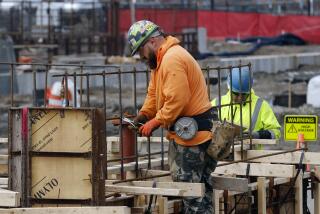High-pay jobs decline as low-pay jobs increase
- Share via
John Soto said he felt like he got “punched in the gut” when BMW announced that it planned to lay off him and other workers at an Ontario parts distribution warehouse and give their jobs to contract workers provided by a third-party company.
“They wouldn’t do this in Germany,” said Soto, 46, referring to the labor-friendly policies in the country where BMWs are manufactured.
Soto was among scores of workers protesting the layoffs Tuesday at the downtown Los Angeles offices of Jackson Lewis, a labor law firm that represents BMW.
A representative for Jackson Lewis referred calls for comment to BMW. The automaker said the switch to the third-party logistics company is not about unions or wages, but rather about operating the Ontario facility as it operates three others — through third-party providers.
Actions to save money by replacing high-paid workers with lower-paid contract jobs without benefits are not uncommon in this economic recovery. In fact, a study released by the National Employment Law Project the same day as the protest indicates that the majority of jobs created in this recovery are lower-paying ones, while higher-paying positions have been slow to return.
Lower-wage occupations such as sales and office clerks, cashiers and food preparation workers grew 3.2% in the first quarter of 2011 from a year earlier, the report said. In contrast, higher-wage jobs such as registered nurses, engineers and finance workers declined by 1.2%. Mid-wage positions such as paralegals, customer service representatives and machinists grew by 1.2%.
“The dominant growth in lower-wage occupations suggests that there is a good jobs deficit that has hollowed out many of the decent work opportunities people are looking for,” said Annette Bernhardt, policy co-director of the National Employment Law Project.
Job losses during the recession were concentrated in mid-wage occupations, the report shows. About 60% of the jobs lost between the first quarter of 2008 and the first quarter of 2010 were mid-wage jobs. About 21.3% were lower-wage occupations and 18.7% were higher-wage occupations.
Further, wages fell even in the lower-wage category. They declined 2.3% from the first quarter of 2008 to the same period in 2011, while pay in mid-wage positions fell 0.9%. Workers in higher-paid positions saw a slight uptick in real wages since the start of the recession.
The study classified jobs as lower-wage if they paid $7.51 to $13.52 an hour (in 2011 dollars), mid-wage if they paid $13.53 to $20.66 an hour and higher-wage if they paid $20.67 to $53.32 an hour.
Many of the Teamsters at the BMW facility fall into the higher-wage category, as they make $25 an hour or more. There’s no telling how much the new workers will make Aug. 31, when the plant will be outsourced to the third-party company.
More to Read
Inside the business of entertainment
The Wide Shot brings you news, analysis and insights on everything from streaming wars to production — and what it all means for the future.
You may occasionally receive promotional content from the Los Angeles Times.











